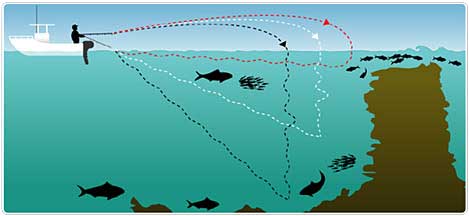Spinning

Few fishing methods are more tried and true than spinning. First developed in the early 20th century, this relatively new technique quickly became a favorite among novice and pro anglers alike. Spinning gear is versatile and easy to use, making it perfect for beginners who are just about to discover their passion for fishing!
What is spinning?
“Spinning” refers to any fishing done on spinning gear, and is suitable for a wide range of species and methods. Spinning gear is especially well suited for freshwater fishing, but anglers use it anywhere and everywhere, whether they’re fishing for Bass, Billfish, or anything in between. With the appropriate rods and reels, you can use spinning gear for most techniques, including casting, bait fishing, trolling, bottom fishing, and more.
Spinning Gear
Spinning Reels
Spinning reels are characterized by the fact that they have stationary spools. As the line around the spool winds and unwinds, the spool stays in a fixed position. This prevents “backlash,” which happens when a moving spool turns faster than the line (such is the case with bait casting and conventional reels). Spin casters (also known as closed-face spinning reels) are very similar to spinning reels, with one key difference: the spool on a spin caster is covered by a protective hood, while spool on a spinning reel is exposed. Simply put, all reels with stationary, exposed spools are spinning reels.
Spinning reels always sit below the reel handle (whereas spin casting and bait casting reels usually sit on top). The position of the reel has a great deal to do with this type of tackle’s user-friendliness. For beginners, it feels more natural to have the reel below the rod; this also allows anglers of different dexterities to hold the rod in their dominant hand.
Spinning reels range from ultra-light models designed to hold 2 lb. test line to heavyweights that can accommodate 30 lb. test.
Spinning Rods
They key difference between a spinning rod and many other rods is the fact that the guides are placed on the underside (since the spinning reel is also under the rod rather than on top of it). Spinning rods vary in length from 4’ ultra-light models to 14’ models that anglers use when surf fishing for monster Sharks. Ice fishermen may use specialized rods even shorter than 4 feet. Many rods are labeled with the line classifications and the weight of objects to be used with them to help you put together a “balanced” spinning gear outfit.
Line Selection
Choosing the right line depends on where you’re fishing, your target species, and other conditions. Nylon monofilament line is a common choice, but braided and fused microfilament lines also cast well on spinning gear.
Anglers use everything from 2-30 lb. test line, but you can count on 6, 8, and 10 lb. test for starters. Lines of these strengths are among the most frequently used in a variety of conditions. Generally speaking, 2-4 lb. test is considered “ultra light” tackle, while 4-6 lb. test is light and 8 lb. test marks the transition into heavy tackle. Of course, this all varies depending on the species and size of the fish you’re targeting. Most spinning reels indicate which strength of line they’re suited for.
Where to Go Spinning
When we said you can use spinning tackle anywhere, we really meant it. Anglers the world over make use of spinning tackle in waters of all kinds, from small mountain streams to deep ocean canyons. To give you a sense of just how versatile this tackle is, we’ve highlighted some of the world’s top fishing grounds and the fish anglers catch there on spinning gear.
Kenai River - Alaska’s Kenai River is home to some of the biggest King Salmon on the planet, including the current IGFA all tackle record (97 lbs 4 oz). It’s common to fish the lower Kenai by drifting and back trolling with spinning gear.
Lake St Clair - Lake St Clair consistently makes its way onto the list of top Bass fishing destinations. For beginners and pros alike, spinning continues to be the method of choice when it comes to catching this iconic gamefish.
The Florida Keys - Flats fishing in the keys is legendary. These shallow waters are a favorite haunt among fly fishermen, but novice anglers who are just starting out on spinning gear can also have a very successful day on the water. Bonefish, Permit, Tarpon–you name it, you can catch by spinning.
Guam - On the opposite end of the spectrum (and the other side of the world), you have the Mariana Trench. Here you can you use spinning gear to fish some of the deepest water on the planet for Wahoo, Tuna, Marlin, Mahi Mahi and more. Time to haul out the heavy tackle!